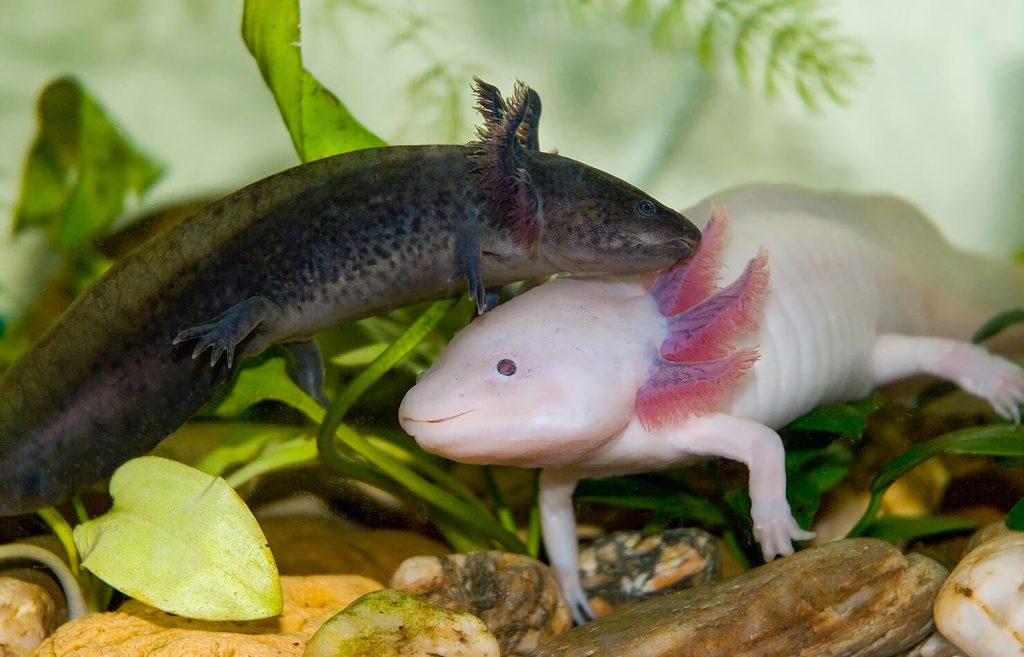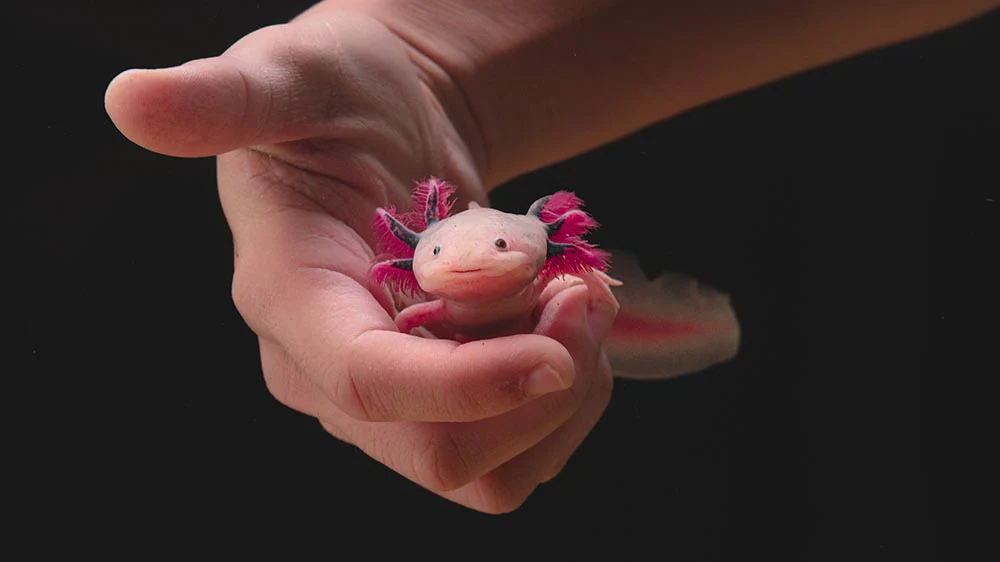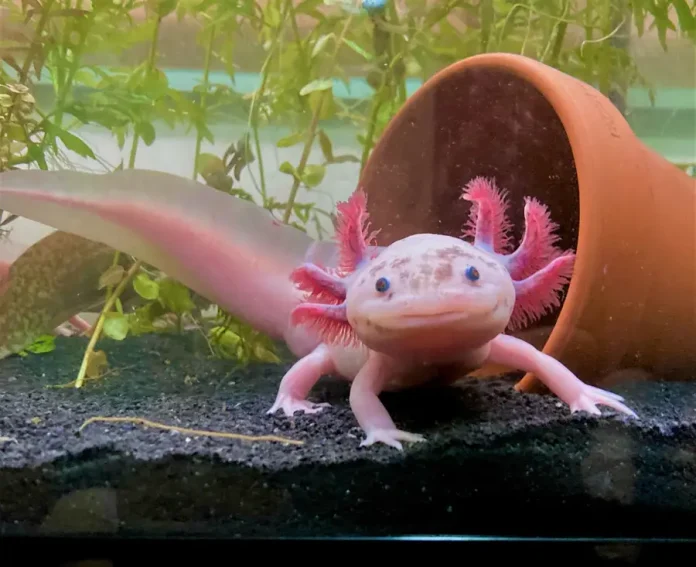Dr. Randal Voss, a professor of neuroscience at the University of Kentucky College of Medicine, often finds himself reminded of the unique stardom surrounding his research subjects: axolotls, a type of aquatic salamander. During outreach events for his laboratory, he frequently encounters enthusiastic fans eager to meet these charming creatures. “They’re so adorable, we love them,” is a sentiment he often hears, showcasing the widespread affection for axolotls. Their playful appearance and unique traits draw people in, making them a captivating subject of study and admiration.
At first glance, it’s easy to see why axolotls have captured the public’s heart. With their wide eyes, cheerful expressions, and soft pink coloring, they exude a delightful, Muppet-like charm. Their rise in popularity can be attributed to various factors, notably their inclusion in the popular video game Minecraft in 2021. This exposure has propelled axolotls into the limelight, leading to their appearances on everything from Girl Scout patches to novelty merchandise. Yet, beneath their cute exterior lies a compelling narrative of scientific exploration, environmental exploitation, and efforts to reconnect humans with nature.

The term “axolotl” has deep historical roots, originating from Nahuatl, the language of the Aztec people. Named after the Aztec god Xolotl, who was believed to transform into a salamander, the axolotl represents more than just a biological curiosity. Its name carries cultural significance, echoing the reverence and mythology surrounding these unique creatures. The correct Nahuatl pronunciation is “AH-show-LOAT,” although many English speakers commonly pronounce it as “ACK-suh-LAHT-uhl.”
As members of the amphibian class, axolotls share a classification with frogs, yet they are distinctive in their development. Most amphibians undergo metamorphosis, transitioning from aquatic larvae to land-dwelling adults. In contrast, axolotls remain in their juvenile, water-dwelling form throughout their lives, a condition known as neoteny. “They maintain their juvenile look throughout the course of their life,” Voss explained, emphasizing that axolotls resemble teenagers for their entire existence. Their signature frilled external gills allow them to breathe in their aquatic environment, which is limited to Lake Xochimilco in Mexico City, their natural habitat.
The reasons behind the axolotl’s lack of metamorphosis remain somewhat enigmatic. Dr. Luis Zambrano, a zoology professor at the National Autonomous University of Mexico, suggests that the unique conditions of Lake Xochimilco, with its abundant resources, might have favored the axolotls’ decision to forgo energy expenditure on transformation. Historically, the chinampas—floating islands created by the Xochimilca people over a thousand years ago—provided a rich habitat for axolotls. The system of canals and floating farms offered protection and resources, allowing axolotl populations to thrive.

However, the chinampas and Lake Xochimilco have faced significant challenges in recent decades. Rapid urbanization and industrialization of Mexico City led to the deterioration of water quality in the lake, turning it into what Zambrano describes as “a bad, smelly pond.” As the lake’s ecosystem suffered, axolotls found it increasingly difficult to survive. The introduction of invasive fish species, such as carp and tilapia, has further threatened axolotl populations by preying on their eggs. Additionally, the aftermath of the 1985 earthquake, which displaced thousands of residents, contributed to habitat degradation around the lake.
These combined threats have taken a toll on axolotl numbers. The International Union for Conservation of Nature now classifies the species as critically endangered, with estimates suggesting fewer than 100 adult axolotls remain in the wild. While wild populations decline, axolotls have proliferated in laboratories and the exotic pet trade, contributing to their scientific significance. “The axolotl essentially helped establish the field of experimental zoology,” Voss noted, highlighting their role in scientific advancements.
The journey of axolotls into the scientific realm began in 1864 when a French army officer introduced them to Europe. Scientists were astonished to discover that these seemingly perpetual juveniles could reproduce, sparking a wave of research into their regenerative capabilities and unique biology. However, while laboratory-bred axolotls have contributed to scientific understanding, they differ significantly from their wild counterparts. Wild axolotls typically exhibit a dark grayish-brown coloration, while the popular pink variants found in pet shops are the result of selective breeding, creating genetic anomalies.
Despite their growing fame in popular culture, the plight of axolotls in the wild remains dire. While the pet trade does not directly deplete wild populations, the widespread presence of axolotls in homes may create a false sense of security regarding their conservation status. Zambrano warns that the visibility of axolotls in popular media might lead to the misconception that they are safe from extinction, obscuring the urgency of their conservation needs. He has dedicated over two decades to axolotl conservation, emphasizing the need for innovative strategies to protect these creatures.

Saving axolotls requires a multifaceted approach that recognizes their close ties to local communities. Conservation efforts must engage with local farmers, known as chinamperos, whose families have cultivated the floating islands for generations. By promoting the restoration of traditional chinampa farming methods, Zambrano believes that cleaner habitats can be established, offering axolotls a better chance of survival. However, achieving these goals necessitates changes in policy and a concerted effort to raise awareness about the significance of axolotls beyond the internet.
The global enthusiasm for axolotls can be harnessed to support conservation initiatives. Individuals can symbolically adopt axolotls, contributing funds to programs aimed at preserving their natural habitat. Zambrano stresses the importance of bridging the gap between digital fascination and real-world conservation challenges. By fostering a deeper understanding of the threats faced by axolotls, advocates can galvanize support for protective measures that ensure these unique amphibians remain a part of our ecological landscape for generations to come.
In summary, axolotls embody a remarkable blend of scientific intrigue and environmental vulnerability. As they capture the hearts of people worldwide, the efforts to understand and conserve them reflect broader themes of human connection to nature. Through collaborative approaches that integrate local knowledge and scientific research, there is hope for restoring axolotl populations and ensuring that these enchanting creatures thrive in their natural habitat once more.




